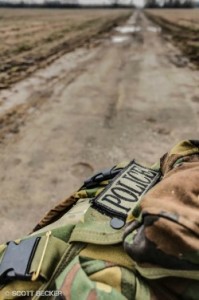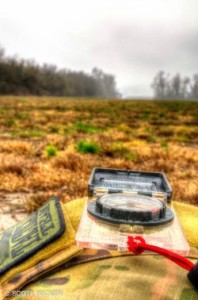Let me admit something right up front. Being a SWAT (law enforcement special operations) Officer is a blast. But here’s something nobody will tell you. Compared to bugging out, a SWAT deployment is a walk in the park. Ok that’s just my opinion, but having done more of both than the average bear, I speak from some experience. To be clear, I’m talking about bugging out in the sense of fleeing-for-your-life from a terrifying situation that turns your entire world upside down in a matter of minutes (or seconds).
By Scott B, a reader of SHTFBlog & Survival Cache.
 So let me share some lessons I learned in SWAT that have also been immensely helpful (and in two cases life-saving) in the bug out realm. These are strategies and tips I’ve learned the hard way, from some of the best in the business. Because facing life threats of all sorts on every mission, every warrant service, every hostage situation actually has a lot of relevance to bugging out from the many of the complex dangers you and I may face if we have to bug out for real.
So let me share some lessons I learned in SWAT that have also been immensely helpful (and in two cases life-saving) in the bug out realm. These are strategies and tips I’ve learned the hard way, from some of the best in the business. Because facing life threats of all sorts on every mission, every warrant service, every hostage situation actually has a lot of relevance to bugging out from the many of the complex dangers you and I may face if we have to bug out for real.
Ironically, being a SWAT cop facing myriad life threats on every mission, every warrant service, and every hostage situation actually has a lot of relevance to the complex dangers you may face bugging out from when the SHTF. So here we go, and I hope you find them as helpful as I have, and that you never, ever have to face a situation where your life depends upon applying these strategic tools.
Camouflage (Not What You Think)
1: Evade Dangers En Route – When you’re in life-threatening situations on a regular basis, you learn to minimize your exposure to unnecessary dangers. In SWAT, this meant that we worked to avoid being detected by bad guys before we were in position to swiftly resolve the situation, while minimizing the risk of harm to everyone involved. How do we apply this to enhancing our bug out survivability? Simply be strategic in avoiding exposure to predatorial dangers while we bug out. Common sense, but here’s where we take the strategic concept and bring it down to the tactical (i.e. practical) level. In order to reduce our exposure to dangers from the human predator, I strongly urge you to apply a holistic approach to your ‘target signature’.

When we talk about disguising your signture, we mean to be smart about camouflaging ourselves from the sensor systems of the human animal. You can read a whole field manual about camouflage, and another on patrolling and tactical movement, but you want fast answers that can help you out right now, not after you’ve earned a master’s degree in visual detection. In order to help save you from detection from predatory criminals, whacked-out zombies, and opportunistic looters, we need to work on reducing that ‘target signature’ in 2 key areas. So here’s a ‘quick and dirty’, but surprisingly effective, cheat-sheet-like approach that has worked well for a lot of our operators, and can help you too!
See No Evil: Eyeballs. Marvels of engineering. Arguably the most adaptable imaging devices on the planet. We used to call ‘em the ‘Mk1 Mod0 Target Detection Device’. When most of us think of ‘camouflage’ the first, and often only, thing we think about is being spotted. And for good reason. Our eyes are tuned to detect motion, color and shape aberrations, misplaced textures, strange contrasts and more. Which means our job as we craft our bug out strategy is as simple as reducing our likelihood of being observed when we don’t want to be. In rural SWAT, this meant doing several things. It meant choosing a uniform camouflage pattern appropriate to the region and season, which helped us blend on approach and also helped identify teammates amidst the semi-chaos following the breach.
However, for many of us wearing camouflage while bugging out is often a bad idea. Why is its own article, so ping us to get that put up for you. Here I will simply say that you want durable clothing in subdued colors, and perhaps a couple cans of spray paint! But don’t stop with the obvious aspect of clothing/camouflage/visual detection, because we need to handle the other senses as well.
Sounds Like Silence: In SWAT, and I’ve found in bugging out as well, we should also handle another key sense, sound. Sound is one of those ‘obvious’ senses that a lot of teammates struggled to really grasp. Especially new troopers tended to think that we were all about ‘shock and awe’. And that was certainly a tool in our toolbox. But even when we chose to use that tool, we routinely employed these tools to minimize our target signatures. We still needed to infiltrate sniper/ observer teams into position, and often stage the team nearby without drawing unwanted attention. Thus, it really boiled down to having control over our noise profile. And the same applies to us preppers, we simply want to control when, and how much, noise we generate and attention we draw to ourselves.
Team Sergeant Solution: Now I’ll give you the simple, yet surprisingly effective tool we used before (pretty much) every mission to help ensure we weren’t jeopardizing our own and team safety. Ironically, I was first exposed to this by a crusty old Special Forces Sergeant Major, so when the SWAT element commander first did the same thing, it felt comfortingly familiar. Do this: Put everyone in your ‘bug out team’ in a line, and simply conduct a basic visual and auditory target signature assessment.
In English that means walk down the line and make sure nobody has shiny stuff hanging off them, forgot to cover the backs of their hands (Pro tip: use gloves when bugging out!), etc. And then have them jump up and down and see how much noise they make. If they’re good-to-go, you will hear very little apart from their boots hitting the ground. No equipment rattles, no sloshing canteens, no clicking of weapon on gear buckles, you get the idea. Hard core? Sure. Are you hard core about saving your life? I hope so!
Defense
2: Maintain Situational Awareness – Want a great saying I learned from a Delta trainer? (I didn’t just tell you that, ahem.) I’ll give you the pithy maxim, and then fill in the context. “Keep Your Head on a Swivel, or else the bad guys will put it on a stick.” My version: “Head on a Swivel or a Stick, its Your Choice.” Which is another way of saying: maintain situational awareness all the time. Remember that we need to prepare for the worst-case, which means we have no support, no backup, no resupply, no advanced medical care, etc. Thus avoidance of life threats is one of our most valuable and effective survival tools. And maintaining your situational awareness, keeping your head on a swivel, is a key way to help protect yourself. Simple, yet life-savingly profound! (yes I made up a word, this concept deserves it)

Terrain
3: Find Good Ground – From Sun Tzu to You, via SWAT. Want a way to dramatically improve your survivability without spending a dime? Assess your bug out terrain ahead of time. You would be stunned how many otherwise squared-away people don’t do this. Don’t make their mistake, fire up Google Earth and get it done today. Fast, easy, and very helpful. What are you looking for? That is an entire book chapter, but let me help get you started. Look for the obvious natural dangers (rivers, cliffs, mountain ranges, etc.) and then look for man-made sources of danger.
That could be an industrial chemical plant, or simply an interstate freeway leading out of an urban area that creates a natural escape corridor for criminals and looters. If you want to take it a step further, look for natural ‘lines of drift’ and other natural funnels that the ill-prepared, and those who prey on them, are likely to gravitate towards. Then plan on avoiding those sources of danger as you plan your bug out route.
Final Thoughts
While you’re at it, use that assessment to also start figuring out the fastest way to bug out, which may not always be the most direct route. Finally, look for additional resources along the way that you may be able to utilize. Remember that in our holistic, pragmatic survival approach, almost everything is a potential survival resource. Oxygen is a resource, as is ammunition, canning jar lids, time, health, and like-minded compatriots. Needless to say, there’s an imperial ton of strategy and tactical tips I don’t have room to share with you right here on all of this, so if you want more, comment below! And there you have it, an unusual article sharing lessons I learned from SWAT that I’ve found very helpful when bugging out in real life, and I hope these serve you too!







Good information that should be taken to heart. Thanks.